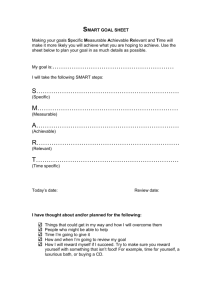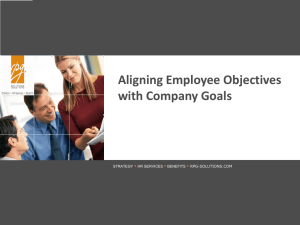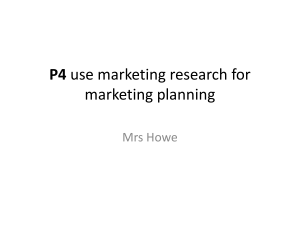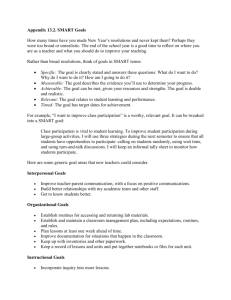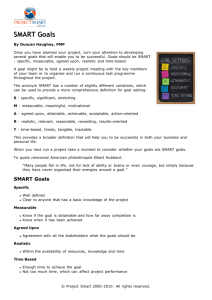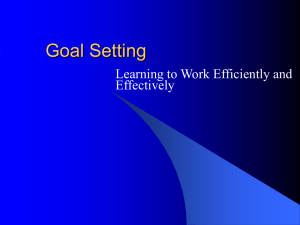Writing SMART Goals and Objectives - College of Micronesia
advertisement
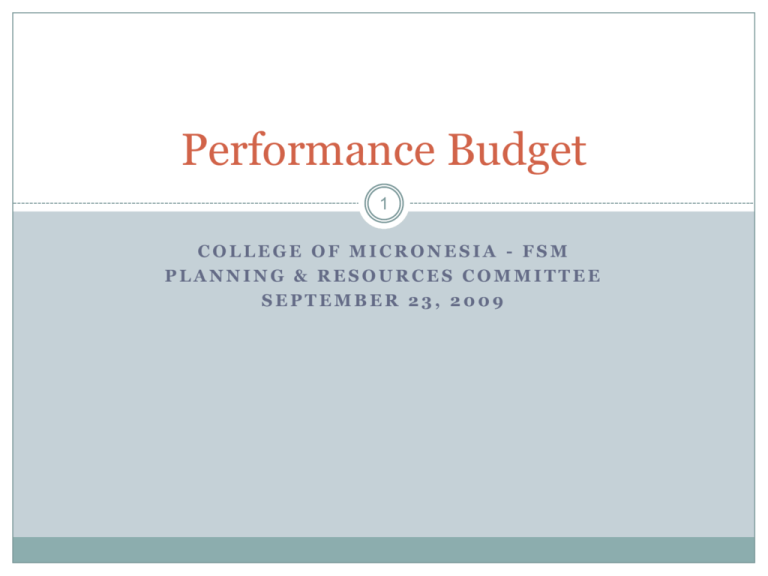
Performance Budget 1 COLLEGE OF MICRONESIA - FSM PLANNING & RESOURCES COMMITTEE SEPTEMBER 23, 2009 Performance budgeting - guiding principles 2 • Be focused on outcomes • Provide simple, accessible information • Be understood and used by all • Be flexible and responsive to the customer • Support interdepartmental efforts • Measure achievement • Encourage continuous improvement • Assist with strategic planning and demand management Performance budgeting - what it does 3 States desired core outcome to be achieved Measures the success in achieving results Helps focus on the high-level outcomes desired Makes the budget more understandable and relevant to the community Empowers staff with flexibility Shows success more comprehensively and clearly (Measures overall service effectiveness) Better alignment: • organizational structure, processes, customerdriven, performance appraisal, training Performance based budgeting and management 4 Links $$ with results Focuses government on key priorities Provides legislature with more information to set budget Enables holding departments accountable Provides monitoring and reporting framework Provides managers information necessary to improve IPOLO 5 Link Input Process/ Activity Output Outcome What are outcomes? 6 •They define the purpose of a service •Why are we here? •What results can we expect from our efforts? •Programs are created around outcomes •Only core outcomes are measured Program outcomes statements 7 WHY? (outcome) A statement of the ultimate goal HOW? (services) A statement of the broad service areas HOW WELL? (measures) Specific measurements of success Four standard measures: Customer Satisfaction, Cost Efficiency, Budget/Cost Ratio, Individual Measures Measures 8 How Well? Measurement of the Success in Achieving the Core Outcome(s). Only high level measures should be used. The outcome measures should focus on quality, effectiveness and efficiency. What results you need to determine whether the purpose has been met. What performance targets (service standards) should be set? Is there at least one measure for each “by” or “through” (strategies) statement? Measures 9 Be based on program goals or objectives that tie to a statement of program mission or purpose Measure program results or accomplishments Provide for comparisons over time Measure efficiency and effectiveness Be reliable, verifiable and understandable Be reported internally and externally Be monitored and used in decision-making Accreditation issues 10 Linking Planning Assessment (including program review) Resource allocation Commitment to continuous improvement Culture of evidence No “trust me” Data is presented to support statements Assumptions are recognized as assumptions and tests are made to determine there validity What is in place at COM-FSM? Strategic plan (planning) 11 Sets mission, values and priority goals of the college Continuous improvement cycle Balanced scorecard – key results by strategic goal (measures) Improvement plans (IAP worksheet #1) Links to institutional mission and goals (links to institutional outcomes to be included in revision) Links to program mission and goals What is to be accomplished (results) Strategies by which it will be accomplished Criteria for success established Linked to revised performance evaluation for supervisors What is in place at COM-FSM? IAP Assessment Process 12 Assessment plans (IAP worksheet #2) Links to intuitional mission and goals Links to program mission and goals Evaluation questions for each improvement outcome/objective Criteria by which you determine success Data sources, sampling analysis identified Timelines and who is responsible Assessment reports (IAP worksheet #3) Were the Improvement outcomes/results achieved to the specified criteria? Closing the Loop – linked to program and institutional mission and goals What is in place at COM-FSM? IAP Assessment Process 13 IAP Handbook Background on quality instruction and services Definition of assessment Assessment techniques Worksheets & directions Improvement plan - objectives/outcomes for performance budget (worksheet #1) Assessment plan (worksheet #2) Assessment report – closing the loop (worksheet (#3) Assistance with student learning outcomes and services objectives/outcomes What is in place at COM-FSM? 14 Policy on continuous improvement cycle Links Strategic plan IAP assessment President’s retreat (priority setting) Budget (performance) Processes and procedures to follow at each stage Focuses the college on continuous improvement at all levels What’s remaining? Performance budgeting (putting in place) 15 Determines what is to be accomplished Based on IAP improvement plan (worksheet #1) Impacted by assessment report that determines if success criteria was achieved for key results Closes the Loop on the improvement cycle (worksheet #3) Allocates resources based on results to be obtained Recognizes success and failure Drives line item budget Links budget items to what is to be accomplished Basis for monitoring and reporting Allocates time as well as dollars ($) Key results/outcomes for COM-FSM 16 Institutional & campus levels Graduation rates Retention rates Based on meeting institutional, program and course student learning outcomes Progression Persistence Transfer rates (internal & external) Course completion rates Program completers Job placement Employer satisfaction Others. Quality, effectiveness and efficiency 17 Improvement of quality of services Instructional techniques that promote increased student learning (meeting student learning outcomes at course, program and institutional level) Satisfaction rates (surveys to be administered in mid October) for colleges programs and services (instructional, student and administrative services) Students Faculty/staff Effectiveness and efficiency Increased productivity (even with reduced resources) Increased accuracy Increased satisfaction Rating on student services and administrative services program rubrics Assists with setting improvement needs (student services developed, administrative services under development) Roles & responsibilities 18 Vice President’s and Campus Directors Ensure that the sum of instructional, student and administrative services result in improvement of key results at each campus and in each service area. Ensure that key results/outcomes are meet Ensures focus on clients (students, community, leaders) IC, SSC, Office Directors Ensure that programs and offices support key results/outcomes of the college Continually improving quality, effectiveness and efficiency of instruction and program services Ensures focus on clients (students, community, leaders) Changes 19 What gets measured gets done. If you don’t measure results, you can’t tell success from failure. If you can’t see success you can’t reward it. If you can’t reward success, you may be rewarding failure. If you can’t recognize failure, you can’t correct it. If you can demonstrate results, you can win public support. Systems and culture must change Push authority and flexibility to lowest levels Aligning organizational infrastructure to support a performance management environment Evolutionary process -- not a quick fix Implementation Issues 20 Determine results to be obtained (quantities, high level) Measures & data sources Writing SMART Objectives/outcomes with by or through strategies & activities Identify outputs for use with FSM BPS Link to results and SMART objectives Financial resources ($ allocation) Human resources (time allocation) Monitoring & reporting Reporting accomplishments against plans Changes 21 Focus on results/outcomes Accountability defined at institution, campus, program levels Success recognized Failure recognized Rewards and incentives for quality work Transparent in allocation and use of resources All programs and services addressed Monitoring & reporting Accomplishments/results against plans Measures SMART goals and objectives 22 S = Specific M = Measurable A = Attainable R = Realistic T = Timebound SMARTer, C-SMART & SMART - S 23 SMARTer SMART objectives that are Extending Reviewed C – SMART SMART Objectives that are also CHALLENGING SMART – S SMART objectives that are also stretching Types of objectives 24 Process objectives lets you know what you are doing and how you will do it; describes participants, interactions and activities Impact objectives lets you know what the long term implications of your program[me]/ activity will be; describes the longer term impact on your target audience or organization Outcome objectives lets you know how you will change attitudes, knowledge or behavior (short term); describe the degree to which you expect this change Personal objectives SMARTer objectives are often written for project management or business and performance management, however as individuals in our personal development plans, SMARTer objectives are also a valuable formula within which to set and individual measure performance. Specific 25 S Specific Stimulating Simple Stretching Succinct Straight forward Self owned Self managed Self controlled Significant Strategic Sensible Measurable 26 M Measurable Motivating Manageable Meaningful Magical Magnetic Maintainable Mapped to goals Achievable 27 A Achievable Appropriate Actionable Attainable Ambitious Aspirational Accepted/ acceptable Aligned Accountable Agreed Adapted Assignable As-if-now Adjustable Adaptable Realistic 28 R Realistic Relevant Results Orientated Resources are adequate Resourced Rewarding Recorded Reviewable Robust Relevant to a mission Timebound 29 T Time-.. bound limited driven constrained related phased sensitive specific stamped lined Tangible- Trackable Traceable Timed/ Timely Toward what you want SMARTer Extending & Reviewed 30 E Extending Exciting Evaluated Engaging Energising Ethical Enjoyable R Reviewed Rewarding Recorded Realistic Relevant Resourced Research Based Definitions 31 Specific Measurable Achievable Realistic Time Objectives should specify what they need to achieve You should be able to measure whether you are meeting the objectives or not Are the objectives you set, achievable and attainable? Can you realistically achieve the objectives with the resources you have? When do you want to achieve the set objectives? Detail Specific 32 Acronym element Description Diagnostic Questions Specific Specific means that the objective is concrete, detailed, focused and well defined. The objective must be straight forwards and emphasize action and the required outcome. Specific also means that it’s results and actionorientated. Objectives need to be straightforward and to communicate what you would like to see happen. To help set specific objectives it helps to ask: WHAT am I going to do? This are best written using strong, action verbs such as conduct, develop, build, plan, execute, etc. This helps your objective to be actionorientated and focuses on what’s most important. WHY is this important for me to do? WHO is going to do what? Who else need to be involved? WHEN do I want this to be completed? HOW am I going to do this? What exactly are we going to do, with or for whom? What strategies will be used? Is the objective well understood? Is the objective described with action verbs? Is it clear who is involved? Is it clear where this will happen? Is it clear what needs to happen? Is the outcome clear? Will this objective lead to the desired results? Detail Measurable 33 Measurable If the objective is measurable, it means that the measurement source is identified and we are able to track the actions as we progress towards the objective. Measurement is the standard used for comparison. For example, what financially independence means to one person, may be totally different compared to what is means for another. If you cannot measure it .. you cannot manage it It’s important to have measures that will encourage and motivate you on the way as you see the change occurring, this may require interim measures. Measurements (and the visible progress) go along way to help us to know when we have achieved our objective. How will I know that the change has occurred? Can these measurements be obtained? Achievable 34 Achievable Objectives need to be achievable, if the objective is too far in the future, you’ll find it difficult to keep motivated and to strive to attain it. Objectives, unlike your aspirations and visions, need to be achievable to keep you motivated. Objectives need to stretch you, but not so far that you become frustrated and lose motivation. Can we get it done in the proposed timeframe? Do I understand the limitations and constraints? Can we do this with the resources we have? Has anyone else done this successfully? Is this possible? Realistic 35 Realistic Objectives that are achievable, may not be realistic….. however, realistic does not mean easy. Realistic means that you have the resources to get it done. The achievement of an objective requires resources, such as, skills, money, equipment, etc. to the task required to achieve the objective. Whilst keeping objectives realistic, ensure that they stretch you. Most objectives are achievable but, may require a change in your priorities to make them happen. Do you have the resources available to achieve this objective? Do I need to revisit priorities in my life to make this happen? Is it possible to achieve this objective? Timebound 36 Time Time-bound means setting a deadlines for the achievement of the objective. Deadlines need to be both achievable and realistic. If you don’t set a time you will reduce the motivation and urgency required to execute the tasks. Agreed Time frames create the necessary urgency and prompts action. When will this objective be accomplished? Is there a stated deadline? Examples 37 Campus retention rate will increase to 60% from Fall 2009 to Fall 2010 by: Strategy 1 Strategy 2 Campus graduation rate will increase to 10% for Fall 2007 cohort by: Strategy 1 Strategy 2 Examples 38 By the end of the asthma management classes, 75% of patients will be able to describe and demonstrate the correct use of a Peak-Flow Meter. By May 10, 2009 the Health Education staff from the Stroke Association will have planned and conducted 4 skills building workshops for 50 carers of recently diagnosed Stroke patients at the Chiswick training centre. Profitability Objectives - To achieve a 25% return on capital employed by August 2009. Market Share Objectives - To gain 25% of the market for sports shoes by September 2009 Promotional Objectives To increase awareness of the dangers of flowers in Wales from 12% to 25% by June 2009. To increase trail of X washing powder from 2% to 5% of our target group by January 2009. Exercise 39 What are your priorities? 1. 1. 2. 3. Review strategic plan Review improvement plans Review assessment reports 2. What measures are appropriate for your area? 1. Review balanced scorecard 2. Review assessment plan 3. Write SMART objectives plus strategies based on your priorities and measures. Exercise 40 What resources are needed to accomplish your improvement plan SMART objectives/outcomes? Human Financial
